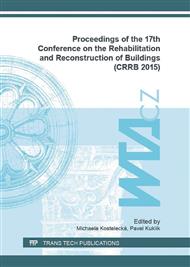[1]
Aydın, S., Development of a high-temperature-resistant mortar by using slag and pumice, Fire Safety Journal, Volume 43, Issue 8, November 2008, pp.610-617.
DOI: 10.1016/j.firesaf.2008.02.001
Google Scholar
[2]
Jong-Pil Won, Hee-Byoung Kang, Su-Jin Lee, Sang-Woo Lee, Joo-Won Kang, Thermal characteristics of high-strength polymer–cement composites with lightweight aggregates and polypropylene fibre, Construction and Building Materials, Volume 25, Issue 10, October 2011, pp.3810-3819.
DOI: 10.1016/j.conbuildmat.2011.03.023
Google Scholar
[3]
Černý, V.; Keprdová, Š. Usability of fly ashes from the Czech Republic for sintered artificial aggregate. Advanced Materials Research. 2014. 2014(887-888). pp.805-808.
DOI: 10.4028/www.scientific.net/amr.887-888.805
Google Scholar
[4]
M. M Shoaib, S. A Ahmed, M. M Balaha, Effect of fire and cooling mode on the properties of slag mortars, Cement and Concrete Research, Volume 31, Issue 11, November 2001, pp.1533-1538.
DOI: 10.1016/s0008-8846(01)00561-0
Google Scholar
[5]
ČSN EN 1363-1. Fire resistance tests - Part 1: General requirements. ČNI, (2013).
Google Scholar
[6]
ČSN EN 1504-3. Products and systems for the protection and repair of concrete structures - Definitions, requirements, quality control and evaluation of conformity - Part 3: Structural and non-structural repair. ČNI, (2006).
DOI: 10.3403/30045530
Google Scholar
[7]
Xing, Z., Beaucour, A-L., Hebert, R., Noumowe, A., Ledesert, B., Aggregate's influence on thermophysical concrete properties at elevated temperature, Construction and Building Materials, Volume 95, 1 October 2015, pp.18-28.
DOI: 10.1016/j.conbuildmat.2015.07.060
Google Scholar
[8]
Minho Yoon, Gyuyong Kim, Gyeong Choel Choe, Youngwook Lee, Taegyu Lee, Effect of coarse aggregate type and loading level on the high temperature properties of concrete, Construction and Building Materials, Volume 78, 1 March 2015, pp.26-33.
DOI: 10.1016/j.conbuildmat.2014.12.096
Google Scholar
[9]
Shi Cong Kou, Chi Sun Poon, Miren Etxeberria, Residue strength, water absorption and pore size distributions of recycled aggregate concrete after exposure to elevated temperatures, Cement and Concrete Composites, Volume 53, October 2014, pp.73-82.
DOI: 10.1016/j.cemconcomp.2014.06.001
Google Scholar


